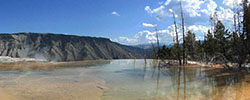
Lesson 1: Intro to Yellowstone
(Estimated time: one approximately 45 minute class period)
Students will be introduced to Yellowstone National Park through a mapping activity and examine facts and statistics about the Park. They will also learn about the scientifically valuable microbial life that lives in Yellowstone’s extreme environments and some of what it takes to plan a research expedition there. Students will also be asked to think about the role that science plays in their lives.
Lesson 2: Limits of Life
(Estimated time: approximately three and a half 50 minute class periods)
- Activity 1: Identifying Gradients
(Estimated time: approximately 25 minutes without the extension)
Students will analyze and identify abiotic gradients in photos of two familiar environments. - Extension Activity: Make your own temperature gradient
(Estimated time: approximately 30 minutes)
Students can measure and graph data from a gradient outside, near their school or
from a demonstration they create in the classroom. - Activity 2: Who’s More Extreme? You, an Insect, a Plant or a Fish
(Estimated time: approximately 25 minutes)
Through graphing temperature limits, students will discover which types of organisms on Earth can survive the most extreme temperature limits. - Activity 3: Yellowstone’s Extreme Life
(Estimated time: 30 minutes)
Students will graph the pH and temperature ranges for some of Yellowstone’s extremophiles and investigate if microbes with different metabolisms sometimes have different niches. - Activity 4: Exploring Yellowstone’s Gradients
(Estimated time: 20 minutes)
Using the knowledge and experience they gained in activities 1-3, students will analyze the gradients of three different types of Yellowstone hot springs. - Activity 5: Sweet Population Sampling
(Estimated time: 45 minutes without the extension)
Students will collect data from models (based on actual research) of the three thermal features they analyzed in activity 4. Students will look at the population distribution of a subset of the microbes that live in these hot springs. The microbes will be represented by different colors of candy. - Extension Activity: Population Pie Chart
(Estimated time: 25 minutes)
Students will calculate the fraction, decimal and percent of each microbe in Mud Pot, Lemonade Creek and Gabby’s Spring then create a pie chart of the microbes to discover which are most prevalent.
Lesson 3: Microbial Mats and Aliens
(Estimated time: one approximately 45 minute class period)
In this lesson, students will discover why scientists looking for life on other planets
are so interested in microbial mats. Students will also analyze a sample core they
collect from a “microbial mat” (actually a layered cupcake) while learning about these
tiny ecosystems including their population dynamics, competitions for resources, and
the energy flow through the different layers of the microbial community.
Lesson 4: The Unseen World Around You
(Estimated time: three approximately 30 minute sessions )
In this lesson, students will devise and test a hypothesis about microbes by collecting samples in different environments and monitoring microbial growth. Students will monitor the samples for microbial growth, the amount of diversity, and answer questions about factors that might impact microbial populations.
Lesson 5: Investigating Hot Spring
(Estimated time: one 45 minute class period)
Students will examine a simulated Yellowstone hot spring to determine temperature values of points at varying distances from the source. They will explore how the environmental factors of pH and temperature influence the growth of organisms in Yellowstone hot springs as well as various other organisms found in different environments.
